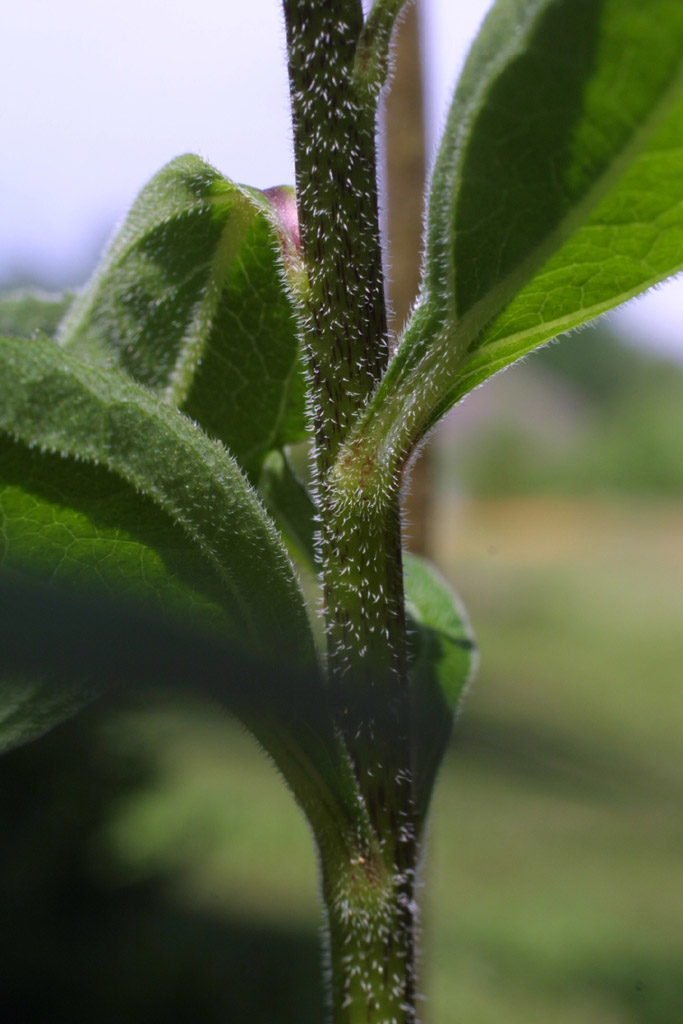Perennials, to 140 cm (caudices vertical or horizontal; plants usually taprooted, fibrous rooted in E. purpurea). Stems erect, unbranched or ± branched (glabrous or hairy, hairs appressed, ascending, or spreading, uniseriate). Leaves basal and cauline; alternate; petiolate (at least basal and proximal cauline, petioles progressively shorter distally); blades (1-, 3-, or 5-nerved) linear to lanceolate or elliptic to ovate (distal smaller), bases mostly attenuate (decurrent on petioles) to cuneate, sometimes rounded or cordate, margins usually entire, sometimes dentate or serrate, faces usually hairy (hairs uniseriate, usually with 1-4 rings of cells surrounding bases), sometimes glabrate or glabrous. Heads radiate, borne singly (on relatively long peduncles). Involucres crateriform to hemispheric, 12-40 mm diam. Phyllaries persistent, 15-50 in 2-4 series (spreading, recurved, or reflexed, linear or lanceolate to ovate, subequal to unequal, mostly herbaceous, apices mostly attenuate, abaxial faces usually hairy, sometimes glabrate or glabrous). Receptacles hemispheric to conic, paleate (paleae orange to reddish purple distally, surpassing disc corollas, bases partially surrounding cypselae, bodies keeled, apices abruptly constricted to awnlike tips; discs 10-45 × 15-40 mm). Ray florets 8-21, neuter; corollas dark purple to pale pink, white, or yellow (tubes glabrous or sparsely hairy, laminae spreading, reflexed, or drooping, linear to elliptic or obovate, abaxial faces glabrous or moderately hairy). Disc florets 200-300+, bisexual, fertile; corollas pinkish, greenish, reddish purple, or yellow, tubes shorter than throats (often sparsely hairy), lobes 5 (erect or spreading to recurved), triangular (pollen usually yellow, usually white in E. pallida). Cypselae (tan or bicolored with dark brown band distally) 3- or 4-angled (faces smooth to finely tuberculate, glabrous or sparsely hairy); pappi persistent, ± coroniform (with 0-4 ± prominent teeth). x = 11.
In keys and descriptions, 'discs' refers to receptacles at late flowering with paleae and florets included in assessing shapes and in measurements of lengths and diameters.
Heads radiate, the rays mostly ca 13(21), neutral or with a vestigial style, often drooping, our spp. purple to white; invol bracts in 2-4 subequal or slightly imbricate series, with firm base and spreading or reflexed green tip, the inner sometimes passing into those of the receptacle, but not sharply divisible into 2 types; receptacle conic, its bracts partly enfolding the achenes, firm, with stout, spinescent tip conspicuously exceeding the disk-cor; disk-cors slightly bulbous-thickened at base, not narrowed to a slender tube; style-branches flattened, without well marked stigmatic lines, and with slender, acuminate, hairy appendage; achenes quadrangular, glabrous or sparsely hairy on the angles; pappus a short, toothed crown; perennial herbs with simple, alternate, entire or toothed, mostly trinerved lvs and solitary or few, mostly long-pedunculate heads. 5, U.S. and adj. Can. (Brauneria)
Gleason, Henry A. & Cronquist, Arthur J. 1991. Manual of vascular plants of northeastern United States and adjacent Canada. lxxv + 910 pp.
©The New York Botanical Garden. All rights reserved. Used by permission.






